Christmas: Williamsburg Style
Book Tells Story of Decorating in the Colonial Capital
photos by Erik Kvalsvik and Harry N. Abrams, Inc.
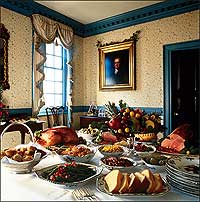
Dr. Philip Barraudís portrait watches over the holiday repast laid on in the dining room of his restored Williamsburg home.
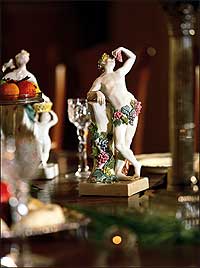
Porcelain figures, such as this 1765 example of Bacchus (left) at the Governorís Palace, graced the tables of the better sort of colonials.
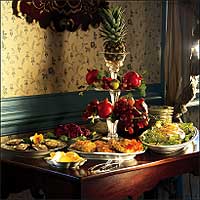
Pyramids of glasses tempt holiday palates with the bounty of the land and the water. The Barraud House sideboard (right) is set with crabcakes, oysters, and fish around a stand laden with fruit.
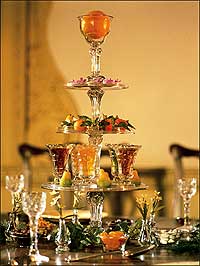
On the Governorís Palace dining table (below) the fare is lighter but as elegantly displayed.
Click image to enlarge
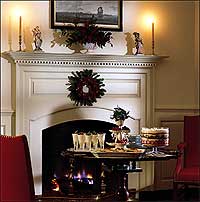
The candlelit mantle and the cheery fire on a hearth with brass andirons invite holiday guests to indulge in a selection of desserts dramatically proffered on an antique tea table in a colonial parlor.
Editor's note: The colonial Christmas story is told from the Williamsburg view in a new book, Williamsburg Christmas: The Story of Decoration in the Colonial Capital. The volume from which this article is extracted takes readers back to the 18th century and on through to the 20th, exploring the sometimes surprising origins of today's Williamsburg Christmas decorating customs.
With its fruited wreaths, candlelit windows, door decorations, and centerpieces, the naturalistic Williamsburg Christmas style has become one of the most popular components of Americaís holiday celebration. Illustrated with more than 100 pictures by photographer Erik Kvalsvik, the book is co-published by Harry N. Abrams and the Colonial Williamsburg Foundation, and available in October in bookstores across the country for $24.95.
When it came to excessive eating and drinking during the Christmas season, Englishmen and colonial Virginians had much in common. A sumptously spread Christmas table had long been a mark of status in Great Britain and it was no less true across the sea. Colonial gentry, like their English counterparts, imitated the aristocractic penchant for dining tables crowded with food. Conspicuous consumption was at its height.
In the 18th century, Christmas offered unlimited opportunities for feasting. Then as now, people gathered with family and friends to celebrate the holidays with the very best they had to offer. Because the season always brought a flurry of weddings, there were wedding feasts to enjoy in addition to lavish midday dinners on Christmas and New Year's Day. In some Southern homes, Twelfth Night, January 6, was the more festive occasion. "It seems," wrote an Englishman traveling through Virginia shortly before the Revolution, "this is one of their annual Balls supported in the following manner: A large rich cake is provided and cut into small pieces and handed round to the company, who at the same time draws a ticket out of a Hat with something merry wrote on it. He that draws the King has the Honor of treating the company with a Ball the next year...The Lady that draws the Queen has the trouble of making the Cake."
A beautifully decorated table was the focal point of every feast. There were, however, rules. Rigid visual requirements governed the proper arrangement of dishes, from the first course to the last. Table settings did not escape the Georgian preoccupation with symmetry: Each platter had to be balanced with a similar one on the opposite side of the table. A familyís reputation rose with the number of dishes presented. Twenty or 30 per course, all precisely ordered around a centerpiece of meats or desserts, was not thought excessive.
Hostesses vied for social status through their dessert tables, presented as the grand climax to a dinner party or as a midnight entertainment during a ball. The elaborate display of sweets showcased a ladyís imagination, cooking skills, artistry, and housewifery accomplishments. Appearances mattered more than taste. A good hostess concentrated on creating an eye-catching centerpiece scene -- usually edible -- surrounded by a profusion of symmetrically arranged desserts. The goal was a spectacle that would astonish with its originality, linger in the memories of the guests for many years, and -- not incidentally -- move the hostess up another rung on the social ladder.
The wealthy few employed special cooks to create miniature landscapes out of sugar, pastry, and marzipan for their holiday tables. Tiny animals molded out of colored sugar or almond paste frolicked through edible garden scenes where everything from the flowers and hedges to the swans swimming on a mirror lake was made of sugar. No doubt the head cook for Norborne Berkeley, Baron de Botetourt, Virginiaís royal governor, dazzled all of Williamsburg in 1769 with his pastoral scene complete with a miniature Chinese temple -- quite the fad in those years -- and various other dessert accessories.
Some hostesses chose to decorate with ornaments that would "serve year after year" such as figurines made of porcelain or marble -- or wax, for the less affluent. Several Williamsburg shopkeepers were more than ready to oblige. Milliner Sarah Pitt advertised in the Virginia Gazette that she had imported from London "shapes, ornaments, and mottoes for desserts, of different sorts and figures." Guests who dined with President George Washington on Christmas Eve, 1795, remarked upon Mrs. Washington's lovely centerpiece with its plaster of Paris statuettes.
A classical mythology theme was popular at early federal dinners: Thomas Jefferson ordered four such figurines for Abigail Adams while he was in Paris. "With respect to the figures I could only find three of those you named, matched in size," he reported in a letter. "These were Minerva, Diana, and Apollo. I was obliged to add a fourth, unguided by your choice. They offered me a fine Venus," he said, "but I thought it out of taste to have two at table at the same time." He settled on Mars.
Although only the wealthiest of Virginia's gentry families could afford to entertain lavishly, modest versions of the dessert table appeared in homes of the "middling sort" as they tried to adapt the style to their own circumstances. Williamsburg ladies would have seen the most elaborate sorts of decorations when they were invited to the Governor's Palace with their husbands, as many were at Christmas in 1769 when "his Excellency the Governor gave a ball and elegant entertainment at the Palace to the Gentlemen and Ladies of this City." For their own homes, they could have purchased confectionery items such as copper molds and figurines from local shops to create a version appropriate to their social status. Any number of cookbooks gave recipes and "Directions to set out a Table in the most elegant Manner and in the modern Taste."
Dining customs changed slowly, but by the 19th century, the extravagances of earlier times were becoming outmoded. And by then, the introduction of the Christmas tree had pulled the decorating emphasis away from the dining table and into the parlor.
Libbey Oliver and Mary Theobald met in the 1970s when they worked for the Colonial Williamsburg Foundation, Oliver as floral services manager, Theobald in product development. Two decades later, they are still steeped in the magic of the Williamsburg Christmas. Three articles in past winter journals told about the evolution of today's holiday, and now, another look at their favorite topic.
Visit our Christmas section (will open in new window).

